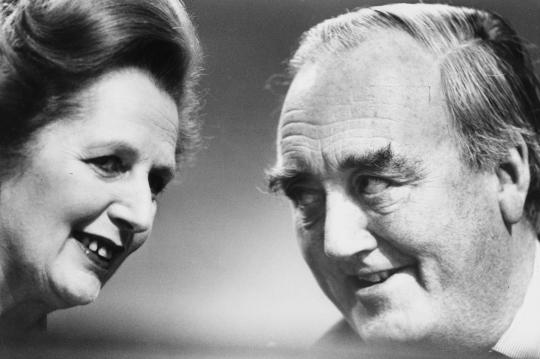#douglas hurd
Explore tagged Tumblr posts
Text
The Young Ones!
#spitting image#lolitics#douglas hurd#michael heseltine#cecil parkinson#geoffrey howe#the young ones#uk politics
24 notes
·
View notes
Link
Douglas Richard Hurd, Baron Hurd of Westwell, is a British Conservative Party politician who served in the governments of Margaret Thatcher and John Major from...
Link: Douglas Hurd
0 notes
Text
Short Sharp Shock - nightmare prison regime
Short Sharp Shock was a military-style prison regime for young offenders that wrecked lives and didn't work as Tony McMahon discovers
One of the first measures introduced by the new Conservative government of Margaret Thatcher in 1979 was the so-called ‘short, sharp, shock’ policy for young offenders. A regime of strict military-style discipline and strenuous physical activity designed to remove criminality from a youth’s character and wipe the smile off their face. It was also described as red meat for the blue rinses – a…

View On WordPress
#1979#80s#detention centre#Douglas Hurd#Jamie Bulger#politics#Send#short sharp shock#Thatcher#William Whitelaw#youth offending
0 notes
Text

Statt Bibelspektakel zur Abwechslung mal ein Ritterspektakel mit Charlton Heston. Der prinzipientreue El Cid eint seinem zweifelhaften König zum Trotz die Spanier samt verständigen Mauren gegen Islamistische Welteroberungspläne. So ist recht! Nur die gute Sophia hat nicht so recht was von ihm. Am Ende ist er tot, aber legendär und reitet dem Sonnenuntergang entgegen, in Technicolor und ..hm.. Supertechnirama.
#El Cid#Charlton Heston#Sophia Loren#Herbert Lom#Geneviève Page#Raf Vallone#Douglas Wilmer#Michael Hordern#Hurd Hatfield#Film gesehen#Anthony Mann
1 note
·
View note
Text
Dread by the Decade: The Picture of Dorian Gray
👻 You can support me on Ko-fi! ❤️

★★★★
Plot: A dark wish ensures that a man's portrait ages while he remains unchanged.
Review: A slowburn that maintains a consistent sense of dread throughout, The Picture of Dorian Gray is an excellent exploration of mortality, guilt, and the horrors that both can wreak.

Source Material: The Picture of Dorian Gray by Oscar Wilde Year: 1945 Genre: Supernatural Horror, Gothic Country: United States Language: English Runtime: 1 hour 50 minutes

Director: Albert Lewin Writer: Albert Lewin Cinematographer: Harry Stradling Editor: Ferris Webster Composer: Herbert Stothart Cast: Hurd Hatfield, George Sanders, Donna Reed, Angela Lansbury, Lowell Gilmore, Peter Lawford, Douglas Walton, Richard Fraser

-----
Story: 4/5 - Unsettling, dramatic, and depressive. While it departs from its source material, it still captures its horror and core themes.
Performances: 4.5/5 - Hatfield's Gray is perfectly cold, creepy, and detached, and Sanders' nihilistic wit is a stand out.
Cinematography: 4.5/5 - Very well framed and lit. Creative camera angles.

Editing: 4/5
Music: 4/5
Effects & Props: 4/5 - The transformed painting and its subsequent shifting are wonderfully grotesque.
Sets: 5/5 - Gorgeous, varied, and ornate.
Costumes, Hair, & Make-Up: 5/5 - Engrossing and elaborate—the woman's gowns and hair especially.
youtube
Trigger Warnings:
Mild violence
Mild body horror
Suicide (offscreen)
Substance abuse (brief)
Orientalism (brief)
#The Picture of Dorian Gray (1945)#The Picture of Dorian Gray#Albert Lewin#American#supernatural horror#Dread by the Decade#review#1940s#★★★★
14 notes
·
View notes
Text
Hi,
I make period drama style gifs. If you use gif packs, please like and reblog them.
Unfortunately, business transactions via PayPal are not available in my country, which makes it impossible to purchase GIF packs on Payhip.com. If you would like to purchase a GIF pack, please send the amount to [email protected]. Also, make sure to include the name of the GIF pack you want in a personal message, and I will send it to you via email.
Most of my projects are already ready, but every day I post no more than 190 gifs. Because that was the reason why my previous account was blocked. I tried to make gif packs in a format more familiar to you with a link to a separate page. However, unfortunately, I did not succeed because of the large format of high-quality gifs.
I want to explain about color processing. Usually, I improve the contrast, brightness and saturation, but leave the naturalness of the film. I don't make the contours too sharp because I like the aesthetic of it looking like a natural image.
Actors in alphabetical order: part 1(A-D), part 2, part 3
Navigation
The arrangement of names may not be alphabetical
▶Page 1
Anne Hathaway Anya Taylor-Joy Asia Argento Astrid Berges-Frisbey Boran Kuzum Camille Rutherford
▶Page 2
Carla Juri César Domboy Callum Turner Cate Blanchett Charity Wakefield Charlie Rowe Chiara Mastroianni Christian Bale Christoph Waltz
▶Page 3
Dagmara Dominczyk Dan Stevens Ella Purnell Emily Blunt Ezra Miller Raffey Cassidy Rebecca Emilie Sattrup Rose Byrne Roxane Duran
▶Page 4
Frances O'Connor Gemma Arterton Hannah Taylor-Gordon Hattie Morahan Hugh Dancy Isabelle Adjani Jude Law Keira Knightley
▶Page 5
Izzy Meikle-Small James Norton Jane Birkin Joanne Whalley Lucy Boynton Jim Caviezel Monica Keena Nicolas Duvauchelle Sally Hawkins
▶Page 6
Adriana Tarábková Dakota Fanning Elle Fanning Gaia Weiss Gwyneth Paltrow Kirsten Dunst Léa Seydoux Pia Degermark Roxane Mesquida Rosamund Pike Samantha Gates Sophia Myles Nell Tiger Free
▶Page 7
Annabelle Wallis Austin Butler Carey Mulligan Guy Pearce James Frain Katie Parker Kate Siegel Olivia Cooke Rachel Hurd-Wood Soko Sujaya Dasgupta Tom Cruise
▶Page 8
Adèle Exarchopoulos Anna Maxwell Martin Charles Dance Emma Williams Gillian Anderson Ian Somerhalder Imogen Poots Matthew Rhys Natalie Press Nina Dobrev Paul Wesley Tamzin Merchant
▶Page 9
Anna Friel Catherine Mouchet Déborah François Dominic West Frédéric Noaille Joséphine Japy Kevin Kline María Valverde Paz Vega
▶Page 10
Ben Whishaw Clémence Poésy Elliot Grihault Emilia Fox Joseph Morgan Lambert Wilson Michelle Dockery Phoebe Fox Sophie Okonedo Tom Hiddleston Tom Hughes Tom Sturridge
▶Page 11
Calista Flockhart Charlotte Gainsbourg Christina Giannelli David Strathairn Felicity Jones Fu'ad Aït Aattou Greta Scacchi Helena Bonham Carter Holliday Grainger Michelle Pfeiffer Rupert Friend Sophie Marceau
▶Page 12
Angela Bassett Brooke Carter Cillian Murphy Danylo Kolomiiets Katie McGrath Keeley Hawes Maria Bonnevie Marta Gastini Miriam Giovanelli Olivia Hussey Oscar Isaac Peter Plaugborg
▶Page 13
Ben Affleck Ben Barnes Ben Chaplin Bill Skarsgård Iben Akerlie Jakob Oftebro Jo Woodcock Josh Hartnett Lily-Rose Depp Reese Witherspoon Ruth Wilson Samantha Soule Taissa Farmiga Tess Frazer Virginie Ledoyen
▶Page 14
Cary Elwes Colin Firth Daniel Day-Lewis Emilia Verginelli Hannah James Jonah Hauer-King Loli Bahia Lorenzo Balducci Rebecca Hall Robin Wright Rupert Everett Willa Fitzgerald
▶Page 15
Annes Elwy Claire Danes Eliza Scanlen Freddie Fox Hugh Jackman Kathryn Newton Louis Partridge Maya Hawke Romola Garai Samantha Mathis Trini Alvarado Winona Ryder
▶Page 16
Douglas Smith Eric Bana Gizem Karaca Jessica Brown Findlay Kenneth Branagh Kit Harington Millie Brady Natalie Dormer Poppy Delevingne Rachel Weisz Rosy McEwen Sam Claflin
▶Page 17
Aubri Ibrag Christina Hendricks Connie Jenkins-Greig Guy Remmers Henry Cavill Imogen Waterhouse Josie Totah Mia Threapleton Olivia Hallinan
▶Page 18
Alex Fitzalan Emma Connell Essie Davis Fahriye Evcen Justine Waddell Natalia Sánchez Monica Bellucci Penelope Cruz Piper Perabo
▶Page 19
Alicia Vikander Alida Baldari Calabria Christopher Abbott Emma Stone Jasmine Blackborow Kim Rossi Stuart Lili Reinhart Louis Cunningham Margaret Qualley Marine Vacth Mark Ruffalo Mélanie Thierry Ramy Youssef Scarlett Johansson Sydney Sweeney
▶Page 20
Antonia Clarke Cameron Monaghan Daisy Edgar-Jones Domhnall Gleeson Heather Graham Isolda Dychauk Kaitlyn Dever Karen Gillan Laoise Murray Madelaine Petsch Olivia Colman Sophie Turner Vanessa Redgrave
▶Page 21
Claire Foy Claire Holt Clementine Nicholson Emily Mortimer Jennifer Beals Kelly Macdonald Lena Headey Perdita Weeks Ruta Gedmintas Sarah Bolger Sting Tom Holland
▶Page 22
Berrak Tuzunatac Burcu Ozberk Cansu Dere Deniz Cakir Melisa Sozen Merve Bolugur Saadet Aksoy Yasemin Allen
▶Page 23
Alesya Romanova Alina Kovalenko Anastasiya Ostreinova Anna Sagaydachnaya Dorota Delag Konstantin Temlyak Kseniya Mishina Marianna Januszewicz Oleksii Yarovenko Olena Lavrenyuk Taras Tsimbalyuk Veronika Shostak
▶Page 24
Amelia Warner Bruce Robinson Cristiana Capotondi Christiane Filangieri David Rott Francesca Annis Golshifteh Farahani Helen McCrory Maisie Williams Nadia Parkes Pierre Niney Uma Thurman
▶Page 25
To do list:
Christopher Gorham under development (The Other Side of Heaven 2001) Harry Melling - The Pale Blue Eye 2022 Nora Arnezeder - Angélique 2013 Isabella Heathcote - Pride and Prejudice and Zombies. Dark Shadows 2012. Beneath Hill 60 2010. Eleanor Worthington-Cox in Gwen (2018) Julie Delpy - La passion Béatrice 1987, Frankenstein 2004, Trois couleurs: Blanc 1994, The Three Musketeers 1993 Nastassja Kinski - Revolution (1985), Tess 1979 Julia Ormond - Young Catherine 1991, First Knight 1995, Legends of the Fall 1994 Laura Donnelly - Beowulf: Return to the Shieldlands, Britannia, Outlander Morena Baccarin in Stargate Isabella Celani - A Room with a View 1985 Neve McIntosh - Gormenghast 2000 Kate Beckinsale - Much Ado About Nothing 1993 Sarah Felberbaum as Maddalena in Medici Rocco Gottlieb - The Book of Vision 2020 Kate Beckinsale - Alice Through the Looking Glass 1998. Stonehearst Asylum 2014. Haunted 1995. Royal Deceit 1994. Love & Friendship 2016. Van Helsing 2004. Pearl Harbor 2001. Michelle Jenner - La catedral del mar 2018, Isabel Aaron Taylor-Johnson - Anna Karenina 2012. Nosferatu 2024. Oskar McNamara
Volker Bohnet — Ludwig 1973 Romy Schneider — Ludwig 1973, Sissi 1955 Helmut Berger — Ludwig 1973
✦Ethan Erickson
Dorian 2003— under development
All of these gifs were made from scratch by me for roleplaying purposes. Feel free to use them as sidebars and reaction gifs. PLEASE DON’T CLAIM THEM AS YOUR OWN.



39 notes
·
View notes
Text
20th anniversary of Peter Pan (2003)
Peter Pan

International theatrical release poster
Directed by: P. J. Hogan
Screenplay by:
P. J. Hogan
Michael Goldenberg
Based on: Peter and Wendy by J. M. Barrie
Produced by:
Lucy Fisher
Douglas Wick
Patrick McCormick
Starring:
Jeremy Sumpter
Jason Isaacs
Rachel Hurd-Wood
Richard Briers
Olivia Williams
Lynn Redgrave
Ludivine Sagnier
Geoffrey Palmer
Cinematography: Donald McAlpine
Edited by:
Garth Craven
Michael Kahn
Music by: James Newton Howard
Production companies:
Universal Pictures
Columbia Pictures
Revolution Studios
Red Wagon Entertainment
Allied Stars Ltd
Distributed by:
Universal Pictures (English-speaking territories and South Africa)
Columbia TriStar Film Distributors International (International)
Release dates:
18 December 2003 (Australia)
24 December 2003 (United Kingdom)
25 December 2003 (United States)
Running time: 113 minutes
Countries:
United Kingdom
United States
Australia
Language: English
Budget: $130 million
Box office: $122 million
#peter pan#wendy darling#john darling#michael darling#george darling#mary darling#captain james hook#mr smee#the lost boys#tinkerbell#peter pan 2003#20th anniversary
7 notes
·
View notes
Text

Title: Dorian Gray
Rating: R
Director: Oliver Parker
Cast: Ben Barnes, Colin Firth, Rebecca Hall, Emilia Fox, Ben Chaplin, Fiona Shaw, Caroline Goodall, Maryam d'Abo, Douglas Henshall, Rachel Hurd-Wood, Max Irons, John Hollingworth, Pip Torrens, Michael Culkin, Nathan Rosen, Jeffrey Lipman Sr, Jo Woodcock
Release year: 2009
Genres: thriller, fantasy, drama
Blurb: Seduced into the decadent world of Lord Henry Wotton, handsome young aristocrat Dorian Gray becomes obsessed with maintaining his youthful appearance, and commissions a special portrait that will weather the winds of time while he remains forever young. When his obsession spirals out of control, his desperate attempts to safeguard his secret turn his once-privileged life into a living hell.
#dorian gray#r#oliver parker#ben barnes#colin firth#rebecca hall#emilia fox#ben chaplin#2009#thriller#fantasy#drama
6 notes
·
View notes
Text
Press Release #16
" MI5 is the best counterintelligence agency in the world. Nothing goes in or out of Britain without us knowing. Rest assured that the safety of Her Majesty's most sensitive secrets and your secrets are also safe with us.
"Rest assured people of the United Kingdom of Great Britain and Northern Ireland, the MI5 is a shield that can never be pierced! all traitors to the country will be caught and face justice!"
- Douglas Hurd
0 notes
Text
Books of 2022
Classroom Management by Dawson Schultz
Shakespeare by Bill Bryson
A Midsummer Night's Dream by William Shakespeare
George VI by Philip Ziegler
Elizabeth II by Douglas Hurd
Fly In The Ointment by Anne Fine
Elizabeth I by Helen Castor
Charmed Life by Diana Wynne Jones
The Lives of Christopher Chant by Diana Wynne Jones
Millennium by Tom Holland
An Inspector Calls by J B Priestley
The Case Against the Sexual Revolution by Louise Perry
Woke Racism by John McWhorter
Let That Be A Lesson by Ryan Wilson
Teaching With Poverty In Mind by Eric Jensen
Boys Don't Try by Mark Roberts and Matt Pintell
How To Manage Your Slaves by Jerry Jones
Reread tons of Discworld in December
0 notes
Text
COMMONS OF HOUSE!
#spitting image#lolitics#house rap#margaret thatcher#neil kinnock#david owen#david steel#nigel lawson#geoffrey howe#roy hattersley#ken livingstone#tony benn#edwina currie#leon brittan#cecil parkinson#nicholas ridley#douglas hurd
11 notes
·
View notes
Text
Israel-Palestine war: Has David Cameron revived the Tory Arabist tradition? Imran Mulla, Peter Oborne 29/11/23
On 6 November 1956, after Britain and France launched a military action in collusion with Israel to occupy the Suez Canal, the Spectator published an editorial denouncing it as an ill-considered “act of aggression”. It was a bold move from Britain’s iconic Tory magazine, one that would age well, on the part of then-editor and proprietor Lord Ian Gilmour.
Gilmour went on to serve briefly as defence secretary under Edward Heath’s Conservative government, and then for two years as Margaret Thatcher’s lord privy seal - until she sacked him in 1981. During that time, and throughout his life, Gilmour belonged to the almost extinct tradition of Tory Arabism and was a staunch and consistent supporter of the Palestinians.
Britain’s new foreign secretary, former prime minister David Cameron, is an important case study in the demise of Tory Arabism. As a young politician, he was influenced by Tory supporters of Palestine, especially Douglas Hurd, whose Witney constituency he inherited, and former party chairman Chris Patten.
As leader of the opposition, Cameron allowed his shadow foreign secretary, William Hague, to strongly criticise Israel’s war in Lebanon in 2006. "I think we can say that elements of the Israeli response are disproportionate,” Hague told MPs in the House of Commons, going on to cite "attacks on Lebanese army units, the loss of civilian life and essential infrastructure, and such enormous damage to the capacity of the Lebanese government".
0 notes
Photo

Handsworth Riots 1985 - Pogus Caesar.
6 notes
·
View notes
Photo

i am suffering right now so i’m gonna spread the pain via this cursed thing i made where i drew 1980s british politicians as gals because of that au i came up with there it’s just a politics club and because i can’t draw adult men fo shizzle. all of them are based on the spitting image portrayals. cecil is wearing a schoolgirl outfit. what the fuck is this.
#lolitics#uk#britain#80s#good god this is cursed#i guess i'll tag each politician in order#john major#norman fowler#geoffrey howes#david owen#nigel lawson#michael heseltine#cecil parkinson#margaret thatcher#douglas hurd#david steel#norman tebbit#spitting image#i am so sorry#politics#my art
23 notes
·
View notes
Text

“The two gymnasts I miss the most in elite are Gabby Douglas and Morgan Hurd. I hope they're both having a great day today.”
24 notes
·
View notes
